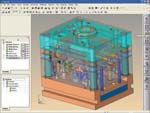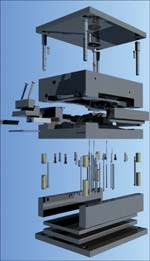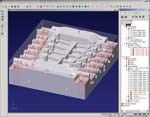Conquering CAD/CAM Challenges
Leading software manufacturers and suppliers reveal how moldmakers can maximize efficiencies using the latest CAD/CAM equipment so they can program and cut complex molds in less time than ever before.
Moldmakers are under constantly increasing pressure from their customers to cut costs, improve quality and shorten leadtimes. To face—and conquer—these challenges head-on, they need to critically examine every portion of the mold design and build process. Beginning with CAD/CAM, getting the right equipment in your shop to suit your specific needs will help you to program and cut complex molds in a shorter amount of time.
A dozen of the leading CAD/CAM manufactures and suppliers discuss the number of challenges moldmakers confront on a daily basis—and what they can do to overcome these hurdles to deliver quality molds on time.
Sam Golan, CEO and president, Cimatron Technologies, Inc. (Novi, MI): We believe that process precedes technology. Moldmakers are facing increasing pressure from their customers to improve quality, cut costs and shorten delivery times. In order to be successful in this highly competitive environment, moldmakers need to invest in establishing the most efficient and effective processes and remove bottlenecks from their operations before they look into which software to use.
In selecting a CAD/CAM solution, moldmakers should look for vendors that are willing to invest the time in understanding the moldmaker's unique business challenges and help establish the processes that will address these challenges before any software is implemented. They also should look for vendors that are focused on their specific industry and provide streamlined implementation processes and superior customer support. It is only through this combination of processes and capabilities that a moldmaker can succeed in these competitive times.
Peter Dickin, public relations manager, Delcam, Inc. (Windsor, ON): The most common challenge is related to ease of use. This means that even companies that can see the potential benefits of newer technology are deterred from investing by the long training times needed to implement the software. With the newer software programs, learning the various functions is easier—meaning that training can focus on how to design more efficient tooling rather than on how to use the software. The other main recommendation would be for companies to choose software developed for toolmaking rather than using more general design software.
Maryann Beaver, marketing coordinator, FeatureCAM (Salt Lake City, UT): Moldmakers need powerful CAD/CAM solutions that can help them program and cut complex molds with less time and effort invested into each part. The following are some of the challenges moldmakers face and how to address these challenges:
High-speed machining—this doesn't just involve higher spindle speeds and feedrates. It also involves using specialized techniques that can be used to machine very thin walls and fine details that otherwise would have been performed by wire EDM. This is accomplished by using smaller tools and a lighter depth-of-cut to produce a high density of toolpaths that are cut at very high speeds. High-speed machining (HSM) also produces very smooth surfaces that require little or no additional processing once the part is removed from the machine. This is all on top of the fact that HSM boosts productivity by producing as much as a 70 percent improvement in material removal rates.
CAM developers support HSM in several ways. First, the order of operations can facilitate part stiffness. Stock needs to be left to support thin features that are likely to deflect under the forces of machining. Toolpaths should be created to avoid sharp changes in direction and favor wide radius moves. Toolpaths also must minimize any moves that could bury the tool in material. Offline verification of high-speed toolpaths is also critical, as well as automation techniques. If it takes too long to program a part, the time and cost savings gained from HSM can be wiped out.
Solid modeling with automatic feature recognition—solid modeling software is becoming more commonplace for many reasons. Gaps or overlaps between part surfaces are avoided—providing a watertight model that is easier to machine. Solid models also let a designer create a digital mockup of a part instead of physically creating a real part. These mockups save time and money because they can be viewed and approved by customers and used for engineering analysis. Direct machining also can be performed on solid models. CAM systems should support solid model programming and importing.
Yvonne Anderson, marketing mana-ger, Gibbs and Associates (Moorpark, CA): Although not specifically a CAD/CAM challenge, offshore competition is probably the number challenge faced by moldmakers today—especially offshore suppliers. As a result, domestic moldmakers need to capitalize on values (other than lower cost molds) they bring to their customers—such as quick turnaround, mold quality and product/process consulting. Today's CAD/CAM software supports moldmakers' efforts in each of these areas.
Also, as the workforce continues to age and retire, the experience level represented by that workforce diminishes. CAD/CAM systems are beginning to incorporate knowledge-based technology that can be used to capture employees' expertise so that it can be referenced and reapplied. Though currently the level of information captured is still fairly simple, it represents a valuable asset for most manufacturers.
In the past, mold, tool and die work often required selecting a CAM system that did a very good job of machining cavities and cores—but was unable to machine the various aspects of mold bases, like slots, channels, coolant lines, ejector and alignment pins. The moldmaker would have to fumble around trying to machine these aspects with a CAM system not suited for these features. Or they would be programmed using a separate CAM system. More and more CAM systems are developing broad functionality to be able to handle moldmaking's broad machining requirements.
Bob Bean, COO, Kubotek USA, Inc. (Marlborough, MA): The main challenge is dealing with all of the types of proprietary CAD files that mold shops receive from various manufacturers/suppliers and all of the standard files as well (IGES, STEP, DXF/DWG). Much time is spent to correct flaws in geometry and produce a mold. It is cost-prohibitive for mold shops to buy one of each of these CAD systems and maintain a proficiency using them. Solutions that offer feature like direct editing can deal with a wide variety of geometries and operate directly on these models. This will save moldmakers time and money.
Steve Bertrand, director of sales, Mastercam/CNC Software, Inc. (Tolland, CT): Because of the pressure of reduced time-to-market and the lower prices of molds, many mold manufacturers are not taking advantage of what they already have. This includes powerful tools they have but don't use, as well as new tools that their software manufacturer releases. Shops should regularly check with their software vendor to see what new and advanced machining techniques are available for their system. Software manufacturers will often release new features through their maintenance plans, and the benefits these new tools can offer are dramatic.
Due to time pressures, many shops just don't have the time to explore all the tools that the software they own already provides. In many cases, software tools that could dramatically affect turnaround time go unused because the user simply doesn't have the time to learn them.
Often these unused tools complement what a shop already does, making the process much more efficient. An example is automated feedrate optimization—a feature that may already be in your software. This technology benefits the user in many ways. For instance, it can save on wear and tear on the equipment, provide a better surface finish, and optimize the feedrate to maximize the utilization of the machine tool. Ultimately, the real value can be measured in dollars by reducing the time it takes to machine the mold.
HSM combines high feedrates with high spindle speeds, specific tools and specific tool motion—delivering faster turnaround and a superior finish. Feedrate optimization lets users run that same job at the most efficient varying feedrates, saving even more time, tool wear and money.
To make sure you are maximizing your software investment, rely on your local reseller who sold you the software. They are there to help you make the most of the software you purchased. A good reseller can quickly give you guidance and point you in the right direction.
Simon Lee, director of sales and marketing, Pathtrace Engineering Systems (Southfield, MI): The issue of having to support a multitude of data formats still exists. The solids-based approach helps here too. There is no single solution that provides for all of their needs, so moldmakers need to understand how to build their own solution. The need to train on multiple systems to achieve their needs is a challenge. The adoption of standard Windows methodology and Web-enabled training systems are of great help in this issue. Good engineers are in very short supply. Making greater use of good skills can be achieved with knowledge-based systems adopting best practice machining methods as defined by the user, not the software. This ensures that the most effective way of doing things becomes the standard.
The globally competitive environment in which they operate demands that moldmakers cut their core/cavity machining time in half—making prismatic machining of the mold a greater proportion of the job. The ability to automate will become key. Mold plate machining is a cumbersome task that is frequently still manually programmed—wasting valuable time and employee resources of skill and knowledge. We had a customer actually give the quote, "We're pleased if we only find two location errors in a plate with 150 holes." After implementing automation for this task, the comment was, "Within 20 minutes I have reviewed the CAD model, and have a single toolpath that machines more than 100 holes of different types and sizes running out in the shop."
Jeffrey Jaje, senior engineer—marketing, Sescoi USA, Inc. (Southfield, MI): Common challenges have not changed over the last 10 years. CAD/CAM users need to be trained and to be kept up to date on new releases of software versions to be most productive. Many companies choose to train their own employees "just what they need to know" and never update them. This stagnates the user and the mold shop from using new technologies that were likely developed to help them be more efficient. One particular customer had a large mold part to rough out, although they had never tried a plunge roughing strategy before, they were willing to let the mill operator give it a try. As it turns out, the customer was removing approximately 16 tons of metal from a 40-ton block. Utilizing the plunge roughing strategy allowed for 50 percent faster metal removal rates than their previous method, which saved days of mill time roughing. If the operator had not been trained and given the opportunity to try something new, they would have lost those extra days.
Fielder Hiss, manager of product management, SolidWorks Corp. (Concord, MA): One challenge is with the first phase of the process cost and design estimating. Mold designers need to estimate material, how the number of actions required to make the part eject, and if the part will fill. Tools like draft and undercut detection correctly identify for the mold designer design areas that will require side cores and lifters. Programs that allow users to evaluate a customer's part and determine based on the design if the part can be filled, identify design problems and allow the mold designer to get back with and communicate more effectively with their customers.
The second major challenge is getting to a point when cores, cavities and electrodes can be machined. Companies can only machine so fast and the design of these components in 3-D is where time can be cut in the overall process.
Glenn Coleman, vice president of product design, Surfware, Inc. (Westlake Village, CA): The most common challenge moldmakers face is one that they are likely not even aware they have: the CAM software they are using is limiting their machining productivity. The limiting factor in material removal rates has never been the machines or the cutting tools, it has always been the input to the machines—the toolpaths themselves.
All existing toolpath generators drive tools into corners where the tool's engage-ment with the material—and consequently the machining load—rises dramatically. To compensate for this, programmers are forced to use smaller stepovers, shallower depths-of-cut, slower spindle speeds and slower feedrates in some combination. This, of course, results in extended ma-chining time, and therefore higher costs.
Paul Brown, director of NX product marketing, UGS (Plano, TX): One of the biggest challenges companies face today is the reuse of non-native data. Customers often look to provide information in their native CAD/CAM system, which may be different than the system used by the moldmaker. Short of purchasing one of every system there are various things that the moldmaker can do.
First, ensure systems can handle translated geometry. The reuse of imported data is a critical part of the process. Systems have to be able to reuse data that may not be created to the same level of tolerance as in their system—allowing for small mathematical errors without causing modeling or manufacturing systems to struggle. The ability for the system to repair geometry with topological problems is an important tool to improve productivity in the process.
Steer your CAD/CAM investments toward open solutions. CAD/CAM systems that are based on a common geometric modeling engine can share geometry with 100 percent compatibility and no data translation.
Another area of advancement that is tightly connected to CAD/CAM that is increasingly critical for moldmakers is in the area of tools that support collaboration. The majority of mold design and manufacture is undertaken by sub-contractors—often in locations remote from the product OEM. Support for the interaction between the OEM, the mold designer, the moldmakers, and possibly a separate production facility, is critical in a global business environment driven by speed and cost control. Often this has been poorly supported, with basic means of data transfer and only crude means to review issues, designs and models on a real time basis. This is changing.
Giovanni Opimitti, president, Vero International (Bingham Farms, MI): The current moldmaking market situation is characterized by fierce global competition. Moldmakers working in areas like North America—where it is impossible to count on a low cost of labor as a competitive advantage—have only one path to follow in order to remain productive and profitable: to implement the most advanced technologies. Only in this way can they be able to perform the most demanding tasks, which for their nature cannot be easily outsourced to a developing country.
The CAD/CAM software plays an important role in this scenario. Moldmakers will need to increasingly adopt CAD/CAM packages not only able to keep up with the technological advancements of connected sectors (e.g., machine tools), but also able to promote themselves as adopters of new technologies. Taking advantage of leading edge technology is vital.
Again, specialization is crucial. The moldmaking process is a very specific one, but at the same time is a large puzzle made of many pieces: data import, analysis, 3-D design, 2-D plot views, two- to five-axis milling, wire EDM, plunge EDM and data export. We believe that the challenge can be tackled—and won—via choosing a CAD/CAM supplier with a proven experience in the entire process, including developing leading-edge technologies as well as providing excellent customer support. In this regard, an efficient technical support to the customers is of paramount importance to establish a virtuous circle: only a deep knowledge of the daily needs of the users can drive the research and development in the right direction.
Thus, when selecting a CAD/CAM vendor, make sure you find one who takes the time to understand the unique challenges your shop faces and is willing to work closely with you to find the right processes for your shop. Your vendor should keep in close contact with you to ensure the latest equipment—as well as machining techniques—is readily available. Making the right CAD/CAM investment is crucial to overcoming design challenges to provide your customers with the shortest leadtimes.
Related Content
How to Improve Your Current Efficiency Rate
An alternative approach to taking on more EDM-intensive work when technology and personnel investment is not an option.
Read MoreWhat is Scientific Maintenance? Part 2
Part two of this three-part series explains specific data that toolrooms must collect, analyze and use to truly advance to a scientific maintenance culture where you can measure real data and drive decisions.
Read MoreHow to Fix Predicted Warpage Before It Happens with Windage and CAD Model Morphing
Applying windage and model-morphing techniques saved toolmaker/molder Sturgis Molded Products the time, cost, headaches of multiple part/mold design iteration loops, cumbersome cooling fixtures, and long molding cycles.
Read MoreFour Micro Tooling Considerations
Issues involving gating, ejection, mold splits and direction of pull are of special concern when it comes to micro tooling.
Read MoreRead Next
Reasons to Use Fiber Lasers for Mold Cleaning
Fiber lasers offer a simplicity, speed, control and portability, minimizing mold cleaning risks.
Read MoreHow to Use Continuing Education to Remain Competitive in Moldmaking
Continued training helps moldmakers make tooling decisions and properly use the latest cutting tool to efficiently machine high-quality molds.
Read More























